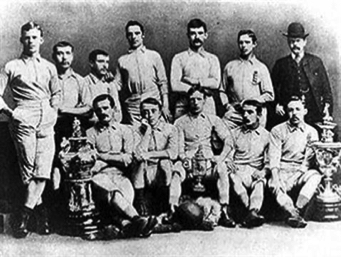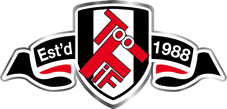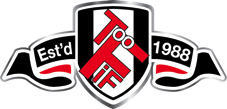There’s only one F in Fulham
The Fulham Fanzine 2019-20 Championship Season
Another chance for a double
We were grateful for our three home points
billp TOOFIF Updated Thursday, 9 January 2020
Blackburn 0 v FFC 0 FEB 8 2020
Match Information
from FFC Online
Competition: Sky Bet Championship
Date: Saturday 8 February 2020
Kick-off: 3:00pm
Venue: Ewood Park, Blackburn, Lancashire
Attendance:
Referee:
Blackburn Rovers
Line-up:
Unused substitutes:
Manager: Tony Mowbray
Fulham
Line-up:
Unused substitutes:
Manager: Scott Parker
Review to follow
99 years ago, onJanuary 8, Fulham were drawn away to Blackburn Rovers in the FA Cup, that game ended in a one all draw.
Fulham won the replay at the Cottage five days later, running out 1-0 wvictors. We drew aaway at Licoln City on January 29, again winning the home replay by one goal to nil. We went out in the net round at home against Wolverhampton Wanderers on February 19 not scoring in reply to Wolve's solo goal.
Early years:
The Blackburn Rovers club was formed in 1875...
The Blackburn Rovers club was formed in 1875 following a meeting on November 5th in the St. Leger Hotel on King William Street. The meeting was organised by two old boys of Shrewsbury school, John Lewis and Arthur Constantine. The purpose of the meeting was to discuss the possibility of forming a football club to play under Association rules. Seventeen people attended the meeting, the majority of whom were Blackburn Grammar School old boys.
This patronage of the club by the educated middle classes was of vital importance. These men were at the heart of Blackburn's commercial life. Through their education and business acumen they were well placed to exploit the opportunities presented by the expansion of the fledgling game.
Rovers' first game, which took place at Church on December 11th 1875, was reported as follows in the December 18th edition of the Blackburn Times.
'On Saturday afternoon a football match was played at Church between members of the Rovers club, Blackburn and the Church club.
The ball was kicked off by the Blackburn captain at three o'clock and after some fine play lasting about thirty minutes, a goal was scored by Birtwistle, of the Blackburn club.
With a hard struggle the Church club succeeded in scoring the next goal and the game resulted in a tie.'
For many years Blackburn and the cotton trade were virtually synonymous. The town's abundant cotton mills and allied trades provided a wealthy educated middle class to form and administer the club. They also provided a vast pool of customers who were drawn in growing numbers to watch the increasingly popular game of association football. After their formation Rovers became one of a small number of clubs formed in the industrial north and midlands who provided a challenge to the more aristocratic amateur southern clubs.
The club's colours were influenced by the fact that several influential club members were Old Malvernians. Thankfully the green and white quartered shirts became light blue and white under the influence of the Cambridge educated members of the club.In the beginning finance was something of a problem. Because they had no ground of their own the only income came from players subscriptions and in the first year these amounted to £2..8s.0d (£2.40p). This was spent on items such as a set of goalposts at 8/10d (44p) and a football for 15/- (75p).
The early playing style adopted by the fledgling club was similar to that used by the gentlemanly southern clubs, a method that became known as the Corinthian style. It was a method that relied more on brute force than sophisticated ball skills, more Wimbledon than Manchester United.
Such was the growing interest in the game there were several other noteworthy clubs in the Blackburn district at this time. Clubs such as Cob Wall, St. Marks, Park Road, Darwen , Church and Blackburn Olympic.
The club's first ground was located at Oozehead, a name that conjures up visions of a debilitating acne attack rather than a venue for top class football. Amongst its more quaint features the ground featured a cow pit (watering hole) near the centre circle. This minor difficulty was overcome by the strategic placing of timber boards and turf over the offending hole for the duration of a match. Not surprisingly, their stay at this venue was short lived. They moved firstly to the Pleasington Cricket Ground and then on to the Alexandra Meadows where on January 2nd 1878 they met the renowned Partick Thistle team. Two goals from Dick Birtwistle brought a famous victory.
Although the club was formed in 1875 details of the early days are very sketchy and it was not until the 1878-79 season that they were covered in detail by the local press. The progress made by the club in the early days can be gauged by the fact that by 1879 they were ready to enter the English Cup for the first time. After defeating Tyne Association and Darwen Rovers they crashed out of the competition following a 0-6 thrashing at Nottingham Forest. At the time Rovers supremacy in Blackburn was under threat from the Blackburn Olympic club that was formed from the amalgamation of the James Street and Black Star teams.
As a result of the need to improve the playing standards of the club Rovers began to look northwards to Scotland for re-enforcements. Friendly defeats at the hands of teams such as Glasgow Rangers had made them aware of the superior ball skills and greater tactical awareness possessed by Scottish players. The capture of the Rangers captain Hughie McIntyre had an enormous influence on the club both on and off the pitch.
The influx of Scots into the game was to cause problems at a later date however when allegations and rumours of professionalism became rife. The first club to seek re-enforcement's from Scotland was Darwen. Their successful recruiting policy established them as a major club and bitter rivals to Rovers. One of their most famous imports was Fergie Suter, a man who was later to become a Rovers stalwart. A stonemason by trade he joined the Darwen club for the 1879-80 season although there is no record of his ever having plied his trade locally. He is said to have found the local stone too hard to work. With no visible means of support the only conclusion people could reach was that Suter was paid to play.
A Lancashire Cup game between Rovers and Darwen on 27th November 1880 revealed the depth of feeling between the two clubs. Bad behaviour on the field was more than matched by bad behaviour off it with the crowd invading the pitch on more than one occasion forcing the referee to abandon the game at half-time. The subsequent loss of Suter to Rovers only aggravated Darwen's feeling of injustice.
For the 1881-82 season the club acquired a new ground at Leamington Street and proceeded to spend £500 providing facilities for the spectators. This move coincided with Rovers best effort in the FA Cup to that date. The 3rd round draw paired them with Darwen. Darwen's fortunes were now in terminal decline following the loss of their Scottish mercenaries and Blackburn enjoyed an emphatic 5-1 victory. As the cup run gathered momentum the town was gripped by cup fever. A semi-final replay victory over the Wednesday increased the temperature still further.
In the Final at Kennington Oval their opponents were the Old Etonians. Despite the backing of many enthusiastic Rovers fans Blackburn lost to the only goal of the game. The defeated team were welcomed back to Blackburn as heroes and they enjoyed some measure of compensation when they defeated Accrington at Burnley Cricket Club to lift the Lancashire Senior Cup.
Rovers love affair with the FA Cup had begun and for the first three decades of the club's existence at least it should be noted that Cup success was of paramount importance to both players and fans alike. The pain of an early Cup exit in the 1882-83 season was not lessened by the feat of Blackburn Olympic who brought the trophy to Blackburn for the first time. In fact they were the first northern team to win the Cup.
Not to be outdone Rovers went all out to emulate Olympic's success the following season. They defeated Southport, South Shields, Padiham, Stavely, Upton Park and Notts County, conceding only one goal in the process before meeting famous Scottish club Queen's Park in the Final. The Final turned out to be full of controversy as the differing interpretations of the off-side rule in England and Scotland resulted in confusion on the pitch.
Rovers ended up winning the Cup for the first time with goals from Brown and Forrest. Unfortunately Queen's Park left the ground complaining they had been robbed by the officials.
Having acquired a taste for the glory a Cup victory brought Rovers proceeded to retain the trophy in 1884-85, beating Queen's Park once again in the final, this time by two goals to nil.
Three points please Santa!
Ah, that was December 25, OK!
billp TOOFIF Sunday, 04 August 2019

Preview from the pre-match Home Page

